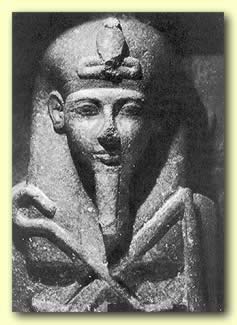- Siptah
Pharaoh Infobox | Name=Siptah |

Caption=
NomenHiero=p:t-H-N36:n-p:t-H-H8:Z1
Nomen="Siptah"
Son of Ptah [Peter Clayton, Chronicle of the Pharaohs, Thames & Hudson Ltd, 1994. p.158]
PrenomenHiero=ra-G25-x:n-ra:stp:n
Prenomen= "Sekhaenre-meryamun" (early form)
"Akhenre-setepenre" (late form)| Golden= Unclear
Nebty= "Saaiunu"
Horus= "Kanakht Meryhapi Sankhtanebemkafraneb"
Reign= 1197 – 1191 BC
Predecessor=Seti II
Successor=Twosret
Dynasty=19th Dynasty
Died= 1191 BC
Spouse=
Burial=KV47 , in theValley of the Kings Akhenre Setepenre Siptah or Merneptah Siptah was the penultimate ruler of the 19th Dynasty and the son of an obscure Queen named Sutailja, of Asiatic origin. His father's identity is currently unknown. Both Seti II and Amenmesse have been suggested. He was not the crown prince, but succeeded to the throne as a child after the death of
Seti II . His accession date occurred on II Peret day 2 around the month of December. [Jürgen von Beckerath , Chronologie des Pharaonischen Ägypten, MAS:Philipp von Zabern, (1997), p.201]Origins
Historically, it was believed that Queen Tiaa, a wife of Seti II, was the mother of Siptah. [Cyril Aldred, The parentage of King Siptah, JEA 49 (1963), pp.41-48] This view persisted until it was eventually realized that a relief in the Louvre Museum (E 26901) "pairs Siptah's name together with the name of his mother" a certain Sutailja or Shoteraja. [Gae Callender, The Cripple, the Queen & the Man from the North, KMT Volume 17, No.1 (Spring 2006), p.52; Callender's source comes from page 140 of Thomas Schneider's ZAS 130 (2003) paper titled "Siptah und Beja"] Sutailja was a Canaanite rather than a native Egyptian name which means that she was almost certainly a king's concubine from Canaan. [Gae Callender, The Cripple, the Queen & the Man from the North, KMT, 2006, p.52] However, Dodson/Hilton assert that this is not correct and that the lady was, instead, the mother of Ramesses-Siptah and a wife of Ramesses II. [The Complete Royal Families of Ancient Egypt, London (2004)] The identity of his father is currently unknown; some Egyptologists speculate it may have been
Amenmesse rather than Seti II since both Siptah and Amenmesse spent their youth in Chemmis [Cyril Aldred, The Parentage of King Siptah, JEA 49 (1963), pp.41-60] and both are specifically excluded fromRamesses III 's Medinet Habu procession of statues of ancestral kings unlike Merneptah or Seti II. This suggests that Amenmesse and Siptah were inter-related in such a way that they were "regarded as illegitimate rulers and that therefore they were probably father and son." [J.E. Harris & E.F. Wente, An X-Ray Atlas of the Royal Mummies (Chicago, 1980), p.147] .A headless statue of Siptah now in Munich shows him seated on the lap of another Pharaoh, presumably his father. The British Egyptologist Aidan Dodson states : "The only ruler of the period who could have promoted such destruction was
Amenmesse , and likewise he was the only king whose offspring would have required such explicit promotion. The demolition of this figure is likely to have closely followed the fall of Bay or the death of Siptah himself, when any shortlived rehabilitation of Amenmesse would have ended" [Dodson, Aidan, (2004), The Complete Royal Families of Ancient Egypt, (Egyptian University of Cairo Press) p.181] . If Siptah was a son of Seti II, it is unlikely that he would have been considered as an illegitimate king by later 20th Dynasty New Kingdom pharaohs. Due to his youth and perhaps his problematic parentage, he was placed under the guidance of his stepmother--the queen regentTwosret . [Callender, op. cit., p.52]Siptah ruled Egypt for almost 6 years as a young man. His stepmother and Seti II's Chief Queen,
Twosret , became the Queen Regent at the Royal Court because of his relative youth. Siptah was only a child of ten or eleven years when he assumed power since a medical examination of his mummy reveals the king to have been a teenager of about 16 years old at death. [G.E. Smith, The Royal Mummies (Cairo 1912), pp.70-73] He was tall at 1.6 metres and had curly reddish brown hair while his left foot was severely deformed presumably frompolio [Smith, op. cit., pp.70-73]Reign
Chancellor Bay publicly boasts that he was instrumental in installing Siptah on the throne in several inscriptions including an Aswan stela set up by Seti, the Viceroy of Kush [LD III, 202c] and atGebel el-Silsila . [LD III, 202a] [Callender, op. cit., p.63] Bay, however, later fell out of favour at Court and last appears in public in a dated Year 4 inscription from Siptah's reign. He was executed in the fifth Year of Siptah's reign, on orders of the king himself. News of his execution was passed to the Workmen of Deir el-Medina in Ostraca IFAO 1254. This ostraca was translated and published in 2000 by Pierre Grandet in a French Egyptological journal. [Pierre Grandet, "L'execution du chancelier Bay O. IFAO 1864," BIFAO 100(2000) pp.339-345] Callendar notes that the reason for the king's message to the workmen was to notify them to cease all work on decorating Bay's tomb since Bay had now been deemed a traitor to the state. [Callender, op. cit., p.54]Siptah himself died sometime in his 6th regnal Year. After his death, Twosret simply assumed his Regnal Years and ruled Egypt as a Queen for a brief while. Siptah was buried in the
Valley of the Kings , in tombKV47 [ [http://www.thebanmappingproject.com/sites/browse_tomb_861.html KV47 Siptah] ] , but his mummy was not found there. In 1898, it was discovered along with 18 others in a mummy cache within the (KV35 ) tomb ofAmenhotep II . An examination of Siptah's mummy reveals that he died around the age of 16 and likely suffered from polio with a severely deformed and crippled left foot. [Callendar, op. cit., p.52] The study of his tomb shows that it was conceived and planned in the same style as those of Twosret and Bay, clearly part of the same architectural design.References
* "Nos ancêtres de l'Antiquité", 1991,
Christian Settipani , p. 175
Wikimedia Foundation. 2010.
